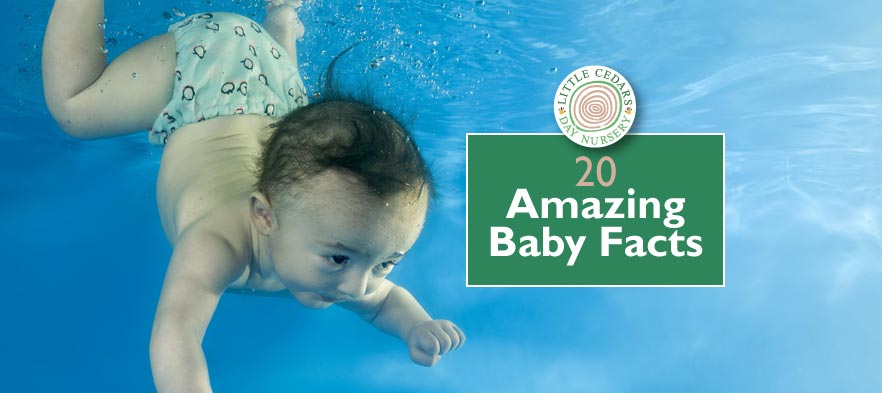
When preparing articles for this website, we often spot interesting baby facts that may surprise people. So, today, we thought we’d share 20 or so of our most surprising discoveries with you. Many are a reminder of just how amazing babies really are!
1. Twenty Babies Born A Minute
Did you know, one baby is born every three seconds. That’s 20 every minute, 1200 every hour and nearly 29,000 every single day.
2. Rapidly Expanding Brains
A baby’s brain will more than double in size in their first year. By the time they’re five, it will have tripled in size compared to its size at birth. The brain will not finish fully developing, however, until the individual reaches their twenties. The brain of newborn boys may also grow faster in the first 3 months than that of newborn girls. It’s something that’s keenly debated amongst experts, though.
 3. Almost 50% More Bones Than Adults
3. Almost 50% More Bones Than Adults
Babies are born with more bones than adults. In time, some will harden and fuse together into just a single bone. Babies’ heads have soft spots when newly born, but which don’t last. That’s because various, separate, bones form their skull at birth. Initially these are connected by something called ‘noggin’, but later the separate skull bones fuse together. Babies are born with around 300 bones. By the time they’re adult’s they will have just 206.
4. But No Kneecaps
Babies do not have kneecaps when they’re born! Had you ever noticed? These finish appearing only once the baby reaches at least 6 months of age.
5. Amazing Taste
Babies have about 30,000 taste buds when they’re born. This is three times as many as adults. This is accounted for by the baby having taste buds not only on their tongue, but also on the sides and roof of their mouths as well as on the tonsils and back of the throat. Despite this, they apparently can’t taste salt until they’re about 4 months old.
 6. Not So Hot on Eye Sight
6. Not So Hot on Eye Sight
Newborn babies are short sighted, only being able to properly focus on an area 8 to 14 inches in front of them — that’s perfect for seeing mum when being breastfed when you think about it. This area of focus will increase with time, of course, and babies also use their peripheral vision to make up for the lack of deeper focus.
7. Fur, Gills & a Tail — Yes, Really!
According to the experts, foetuses have gills, fur and even a tail during development. All three end up disappearing either before birth or, often in the case of fur, within the first few weeks after being born. The tail will have become the coccyx and the ‘gills’, which are temporary slits (pharyngeal arches) in the neck, will have developed into jaw and ear bones by the time the babies have been born.
8. No Tears for Weeks
Babies don’t cry tears until they’re about a month old. Until then, it’s rather like ‘dry’ crying.
 9. Natural Born Swimmers (… Kind of)
9. Natural Born Swimmers (… Kind of)
Newborns hold their breath underwater automatically and even adapt their heart rate and peripheral blood vessels when doing so. We strongly advise against you testing this, of course, but apparently it’s true. This natural ability does not last past the age of six months, however.
10. Baby Time in the Womb
Some interesting statistics suggest that, on average, female babies remain in the womb a day longer than males, white babies remain there 5 days longer than black babies and Indian babies remain there 6 days longer than white babies. If true and not simply a momentary glitch, the reasons for this are a bit of a mystery.
11. No Memory Before Three
People’s long-term memories go back no earlier, in general, than the age of three. This is believed to be because either memory function hasn’t developed sufficiently until then or because memory may be tied to the ability to understand language.
12. Recognising Day & Night
It can take up to 12 weeks before a baby will recognise the difference between day and night. Hence, the irregular sleep pattern that can last until they’re 5 or so months of age.
13. Eyes to the Right
85% of newborn babies prefer to face to the right when lying on their back. The preference only lasts a few months, but may also be an indicator of whether they’ll turn out to be right-handed or left-handed.
 14. Is Breast Really is Best?
14. Is Breast Really is Best?
As well as protecting against diseases, breastfeeding babies for at least 2 months halves the risk of Sudden Infant Death Syndrome (SIDS) — that’s incredible when you think about it. It also gives greater protection from SIDS the longer you continue.
15. And Breast Milk Adapts Like Magic
Expressed breast milk for a baby should never exceed 4oz per bottle no matter what age they are. While formula-fed infants have bigger bottles as they grow older, babies fed via bottles containing expressed breast milk should stick to 4oz (1 to 1½oz per hour) maximum. That’s because the breast milk adapts itself to their precise needs as they grow; it constantly changes its composition as the child gets older and that includes calorie content contained per ounce. That’s clever!
 16. The Only Smiling Primate
16. The Only Smiling Primate
Human babies are the only primate babies that smile at their mother or father. That’s quite remarkable, although we wonder whether other primates have a different way of smiling that we don’t recognise or understand.
17. Special Birth Months
According to statistics, the most common date of birth is the 9th of September. This is closely followed by the 19th, 12th and 17th of September, in that order. Interestingly, babies born around this time stand the best chance of being the smartest in the class and going on to have the greatest success in life. We considered whether this could be linked to school starting in September, making these children the oldest, most mature pupils in the class at a time when learning and development is so crucial.
Meanwhile, people born in October seem to live the longest, living on average 160 more days than those born in the Spring.
Scientific evidence also points to the month of birth affecting personality. For example, those born in the summer months having the most optimistic outlooks.
18. And the Not So Special
Meanwhile, December, January and February are the least common months for births, with December 25th and 26th seeing the fewest during the entire year.
 19. Outcomes of Being First Born
19. Outcomes of Being First Born
Children who are first-born are 1.7 times more likely than their younger siblings to live to the age of one hundred. Those with young mothers at birth stand the greatest chance of doing so. The first born is statistically more likely to have better mental health but have a slightly higher propensity to be overweight or have high blood pressure. Firstborns are often natural leaders but younger siblings may experience that simply as bossiness when growing up!
20. The Origins of ‘Infant’
The term ‘infant’ comes from the Latin ‘infans’, which means ‘unable to speak‘ … which makes sense, when you think about it.
We hope that you have found these surprising facts of interest and have perhaps learned something you didn’t know before — we certainly enjoyed putting them together for you.
High Quality Childcare in Streatham
 We are Little Cedars, a pre-school and childcare nursery in Streatham. As well as being one of the best nurseries in the London SW16 area, we would also make a convenient choice for anyone requiring childcare nurseries, pre-schools or playgroups in/around Balham, Tooting, Norbury, Colliers Wood, Furzedown, Streatham Common, Streatham Hill and Streatham Park. Why not book a visit, register for a nursery place, or ask any questions — our childcare professionals are here to help:
We are Little Cedars, a pre-school and childcare nursery in Streatham. As well as being one of the best nurseries in the London SW16 area, we would also make a convenient choice for anyone requiring childcare nurseries, pre-schools or playgroups in/around Balham, Tooting, Norbury, Colliers Wood, Furzedown, Streatham Common, Streatham Hill and Streatham Park. Why not book a visit, register for a nursery place, or ask any questions — our childcare professionals are here to help:

 3. Almost 50% More Bones Than Adults
3. Almost 50% More Bones Than Adults 6. Not So Hot on Eye Sight
6. Not So Hot on Eye Sight 9. Natural Born Swimmers (… Kind of)
9. Natural Born Swimmers (… Kind of) 14. Is Breast Really is Best?
14. Is Breast Really is Best? 16. The Only Smiling Primate
16. The Only Smiling Primate 19. Outcomes of Being First Born
19. Outcomes of Being First Born
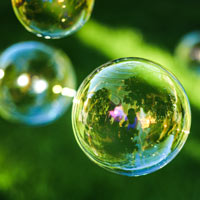 Sensory Play Ideas for Babies
Sensory Play Ideas for Babies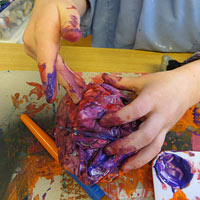 • Paper. Babies will love the feeling of scrunching up paper and will notice the sound as well as the contoured feel of their new creation. They may need a demonstration to get started, though. They’ll start to comprehend the concept that something in one form, like a pristine, wafer-thin sheet of paper, can be made into something completely different — in this case, perhaps a simple ‘ball’ of scrunched-up paper. Even
• Paper. Babies will love the feeling of scrunching up paper and will notice the sound as well as the contoured feel of their new creation. They may need a demonstration to get started, though. They’ll start to comprehend the concept that something in one form, like a pristine, wafer-thin sheet of paper, can be made into something completely different — in this case, perhaps a simple ‘ball’ of scrunched-up paper. Even 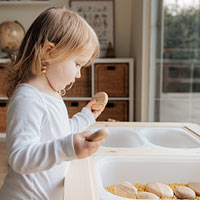 • Different objects & materials: babies will enjoy playing and learning about the properties, touch, feel and sound of different objects and materials. For example, (safe) wooden utensils, water in a closed beaker or bottle or small plastic or card boxes that they tap like a drum, or try to stack into a ‘wall’ — and so on. They’ll learn about physical properties of each along the way, including sounds, textures, touch and, if they include some carefully chosen food items, taste. It’s amazing what fun babies will have with such simple items — often learning far more from these than from purchased toys.
• Different objects & materials: babies will enjoy playing and learning about the properties, touch, feel and sound of different objects and materials. For example, (safe) wooden utensils, water in a closed beaker or bottle or small plastic or card boxes that they tap like a drum, or try to stack into a ‘wall’ — and so on. They’ll learn about physical properties of each along the way, including sounds, textures, touch and, if they include some carefully chosen food items, taste. It’s amazing what fun babies will have with such simple items — often learning far more from these than from purchased toys. • The natural world: babies also greatly enjoy the simple pleasures offered by the natural world. A breeze on their faces may greatly intrigue them, even more so when they see leaves rustling and moving a little on the ground. The feel and texture of grass on the lawn or the sight of sunlight dappling through the trees or reflecting off puddles can be wondrous to them. Under close supervision, getting to know the textures, hues and smells of safe, natural objects outdoors can also be a source of sensory discovery.
• The natural world: babies also greatly enjoy the simple pleasures offered by the natural world. A breeze on their faces may greatly intrigue them, even more so when they see leaves rustling and moving a little on the ground. The feel and texture of grass on the lawn or the sight of sunlight dappling through the trees or reflecting off puddles can be wondrous to them. Under close supervision, getting to know the textures, hues and smells of safe, natural objects outdoors can also be a source of sensory discovery.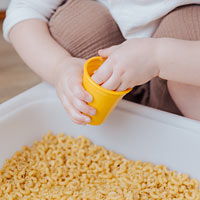
 • Hand & foot prints: preschoolers will never be bored with smothering their hands or feet in coloured paints, then making prints on paper or card. Footprints and handprints can be random or used to make images or patterns. This process is both creative and a sensory experience for them as the cold paint squelches between fingers or toes. They’ll learn so much including about mixing pigments, creating images from simple printed shapes, about the concept of paint eventually drying to form something semi-permanent and about different textures being formed, depending on the consistency of the paint. We take these discoveries for granted as adults, but we would originally have had to learn about them during our early, formative years.
• Hand & foot prints: preschoolers will never be bored with smothering their hands or feet in coloured paints, then making prints on paper or card. Footprints and handprints can be random or used to make images or patterns. This process is both creative and a sensory experience for them as the cold paint squelches between fingers or toes. They’ll learn so much including about mixing pigments, creating images from simple printed shapes, about the concept of paint eventually drying to form something semi-permanent and about different textures being formed, depending on the consistency of the paint. We take these discoveries for granted as adults, but we would originally have had to learn about them during our early, formative years. • Food creativity: toddlers can also take playing with food to the next level by introducing the concept of making images out of things like fruit- or vegetable-based sauces, cream or yogurt. Whole pictures can be made of food, using the hands, for example using broccoli for ‘trees’, peas for grassy areas and so on. The whole thing can smell great and even be tasted! Playing, hands-on, with food in this way can be fun and creative but also help children learn to accept new foods and tastes into their diets. However, care needs to be taken because proper mealtimes require good manners and children need to understand that food is not usually for playing with.
• Food creativity: toddlers can also take playing with food to the next level by introducing the concept of making images out of things like fruit- or vegetable-based sauces, cream or yogurt. Whole pictures can be made of food, using the hands, for example using broccoli for ‘trees’, peas for grassy areas and so on. The whole thing can smell great and even be tasted! Playing, hands-on, with food in this way can be fun and creative but also help children learn to accept new foods and tastes into their diets. However, care needs to be taken because proper mealtimes require good manners and children need to understand that food is not usually for playing with.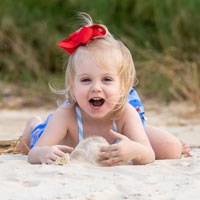 • Sensory sand: it’s very rare for little ones to dislike playing with sand, which allows youngsters to get hands-on creatively. They can learn about the unique and varying textures, consistencies and properties of sand, depending on how much moisture it contains. Dry sand has its own unique set of properties, acting and feeling almost like a powder. Very runny, wet sand is great fun as it can be used to run through the hands and ‘set’ into pointy mountain shapes that look quite magical. Or, when less water is added, sand can be fashioned into shapes and, of course, “castles”, using the hands or by filling buckets, hollow vessels, or tubs. Children can also press their hands and feet into level, damp sand in a sandpit or tray, to make impressions and patterns. It feels great too and is an almost essential part of childhood. Young children learn so much from this stimulating, multi-sensory type of play.
• Sensory sand: it’s very rare for little ones to dislike playing with sand, which allows youngsters to get hands-on creatively. They can learn about the unique and varying textures, consistencies and properties of sand, depending on how much moisture it contains. Dry sand has its own unique set of properties, acting and feeling almost like a powder. Very runny, wet sand is great fun as it can be used to run through the hands and ‘set’ into pointy mountain shapes that look quite magical. Or, when less water is added, sand can be fashioned into shapes and, of course, “castles”, using the hands or by filling buckets, hollow vessels, or tubs. Children can also press their hands and feet into level, damp sand in a sandpit or tray, to make impressions and patterns. It feels great too and is an almost essential part of childhood. Young children learn so much from this stimulating, multi-sensory type of play.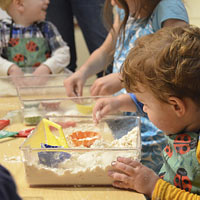 • Playing with dough: whether bought or home-made, dough is always a big hit with young children. It can be fashioned with the hands into shapes, characters, animals and mini-sculptures. Using food colouring in dough also allows children to discover more about mixing pigments. Salt dough can also be baked (under the close supervision of an adult) so that it hardens into more permanent creations. Many types of dough even smell great too! What’s more, it can even lead to a bigger interest in cooking real, edible dough and other baked foods when they’re a little older.
• Playing with dough: whether bought or home-made, dough is always a big hit with young children. It can be fashioned with the hands into shapes, characters, animals and mini-sculptures. Using food colouring in dough also allows children to discover more about mixing pigments. Salt dough can also be baked (under the close supervision of an adult) so that it hardens into more permanent creations. Many types of dough even smell great too! What’s more, it can even lead to a bigger interest in cooking real, edible dough and other baked foods when they’re a little older. • A sensory garden. We’ve left perhaps the best until last. Making a sensory garden area with, or for, little ones will give them a magical experience. There are so many materials that can be used in the construction of sensory gardens, including soil, earth, pea shingle, tree bark, moss and so on. Plants themselves will also add to the fascinating mixture of textures, colours and even smells found within a sensory garden. It can be as small or large as you have room for and can even be achieved in containers, pots or on balconies for those who do not have gardens. It can take many forms so it’s design also gives children a wonderful creative opportunity. Sensory gardens are a complete feast for the senses for young children — adults too — encompassing touch (e.g. the textures of materials, moss and plants), smell (why not include some herbs — these smell wonderful and can be tasted too), potentially sound (crunchy gravel, rustling leaves etc.), sight (aesthetics, colour etc.) and will also give children ample opportunity to improve balance and body awareness as they construct and create in this unique space.
• A sensory garden. We’ve left perhaps the best until last. Making a sensory garden area with, or for, little ones will give them a magical experience. There are so many materials that can be used in the construction of sensory gardens, including soil, earth, pea shingle, tree bark, moss and so on. Plants themselves will also add to the fascinating mixture of textures, colours and even smells found within a sensory garden. It can be as small or large as you have room for and can even be achieved in containers, pots or on balconies for those who do not have gardens. It can take many forms so it’s design also gives children a wonderful creative opportunity. Sensory gardens are a complete feast for the senses for young children — adults too — encompassing touch (e.g. the textures of materials, moss and plants), smell (why not include some herbs — these smell wonderful and can be tasted too), potentially sound (crunchy gravel, rustling leaves etc.), sight (aesthetics, colour etc.) and will also give children ample opportunity to improve balance and body awareness as they construct and create in this unique space.